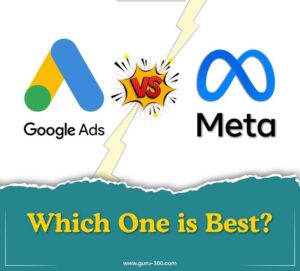In the fast-evolving world of digital marketing, businesses face a crucial decision when allocating their advertising budgets: Google Ads or Meta (formerly Facebook) Ads? Both platforms offer immense potential to reach target audiences, but they operate on different principles and cater to varying marketing goals. This article will compare Google Ads and Meta Ads based on reach, targeting options, ad formats, cost-effectiveness, and return on investment (ROI).

1. Understanding the Basics
Google Ads
Google Ads is a pay-per-click (PPC) advertising platform that allows businesses to place ads on Google’s search results pages, YouTube, and partner websites. Since Google processes over 8.5 billion searches per day, advertising on this platform provides an opportunity to capture high-intent users actively searching for products or services.
Meta Ads
Meta Ads, which includes Facebook and Instagram advertising, is a social media advertising platform that enables businesses to target users based on their demographics, interests, and behaviors. Unlike Google Ads, which relies on search intent, Meta Ads focus on audience engagement, brand awareness, and storytelling.
2. Reach and Audience Targeting
Google Ads: Keyword and Intent-Based Targeting
Google Ads work best for businesses targeting users actively searching for a product or service. With options like Search Ads, Display Ads, Shopping Ads, and YouTube Ads, businesses can attract potential customers based on keywords and search queries.
Meta Ads: Interest and Behavior-Based Targeting
Meta Ads allow businesses to target users based on their online behavior, demographics, and interests. With advanced AI-driven audience insights, businesses can create highly personalized ads that appear in users’ feeds, stories, and Messenger apps.
3. Ad Formats and Placement
Both platforms offer a variety of ad formats:
- Google Ads: Text ads, display ads, shopping ads, video ads, app ads.
- Meta Ads: Image ads, video ads, carousel ads, slideshow ads, story ads, Messenger ads.
Google Ads are more effective for direct response marketing, whereas Meta Ads work better for engagement-driven campaigns.
4. Cost-Effectiveness
Google Ads Pricing
Google Ads follows a cost-per-click (CPC) model where advertisers bid on keywords. The average CPC varies based on industry, competition, and keyword intent, often ranging from $1 to $50 per click.
Meta Ads Pricing
Meta Ads operate on a cost-per-click (CPC) or cost-per-impression (CPM) model. The average CPC for Facebook Ads is typically lower than Google Ads, ranging from $0.50 to $5 per click, making it an affordable option for brand awareness campaigns.
5. Return on Investment (ROI)
- Google Ads is best for businesses looking for direct conversions, as users already have high intent when searching for products or services.
- Meta Ads provide better ROI for businesses focused on brand awareness, customer engagement, and community building.
Final Verdict: Which One Should You Choose?
- Choose Google Ads if you want to capture high-intent customers, drive sales quickly, or run product-specific search campaigns.
- Choose Meta Ads if you aim to increase brand awareness, engage with audiences, or sell visually appealing products through social media.
- Ideally, a combination of both platforms maximizes marketing success, leveraging Google Ads for search-driven conversions and Meta Ads for brand storytelling and customer engagement.
Both platforms have their strengths, and the best choice depends on your business goals, budget, and target audience. By strategically using both, businesses can create a well-rounded digital marketing strategy that drives results.